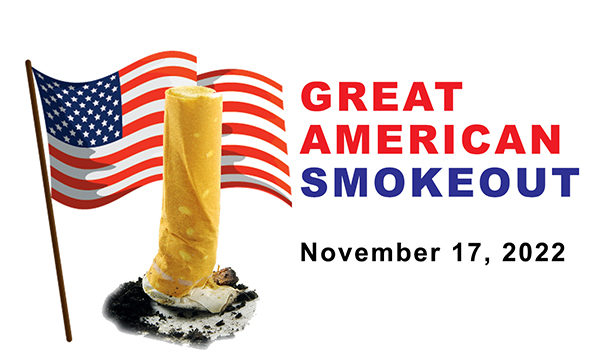The Great American Smokeout
By Kirsti Coghlan, Mauch Chunk Trust, CCEDC Health & Wellness Committee
The Great American Smokeout begins this month of November…

Quitting tobacco is one of the best things you can do for your health, but it’s not easy. Why is quitting such a challenge? You may be able to think of many reasons, but here are a few examples that affect most people:
• Nicotine is physically addictive, so your body craves it.
• Unpleasant withdrawal symptoms, which you want to avoid, occur when nicotine is withheld.
• Smoking, dipping, vaping, and chewing are habits, which are automatic and hard to change.
• Using tobacco brings you pleasure, which causes an emotional dependence.
• The desire to smoke, dip, vape or chew is triggered by certain situations, emotions, environments and other circumstances.
The more you clearly identify the reasons you use tobacco and the reasons you want to quit, the more likely you will be to succeed.
Our wellness coaches are ready to help! Help prepare you to quit, give you support while you quit, and help you look forward to a tobacco free lifestyle. To speak to a wellness coach or enroll in the How to Be Tobacco-Free program call 1.800.650.8442.
Remember, it’s not just you who suffers from the effects of your tobacco habit. Each time you light up, you expose the people you care about to secondhand smoke. In public places, people you don’t know are harmed by the secondhand smoke, too. Sidestream smoke is the smoke that comes off the burning end of the cigarette, cigar, etc. Mainstream smoke is the smoke that comes into the air through the cigarette’s mouthpiece when the smoker puffs and includes the exhaled smoke after each puff.
UNDERSTAND THE TOXINS FOUND IN SECONDHAND SMOKE
• Tar – the same chemical used to pave streets (and the yellow and brownish deposits on some smoker’s teeth)
• Nicotine – a neurotoxin that was widely used as an insecticide in the past; acts as a stimulant in humans, which is one of the main reasons for its dependence-forming properties
• Carbon Monoxide – an atmospheric pollutant and poison
• Methane – a major component of natural gas; highly explosive; suggested as a possible contributor to global warming
• Nitrogen Dioxide – a toxin; long-term exposure is known to cause adverse health effects
• Cadmium – known to cause cancer; used largely in batteries and pigments for plastic products
• Benzopyrene – an aromatic hydrocarbon that is a carcinogen found in coal tar, cigarette smoke and automobile exhaust fumes
• Ammonia – a caustic and hazardous compound; used in fertilizers
• Hydrogen Cyanide – a poison used for capital punishment in gas chambers; used in chemical warfare for general poisoning
• Acetone – used in nail polish remover, paint thinner and superglue remover
• Formaldehyde – classified as a probable human carcinogen; used to temporarily preserve dead bodies
It’s time to challenge yourself! On November 17, 2022 The American Cancer Society sponsors the Great American Smokeout. This event challenges smokers and all tobacco users to give up tobacco for 24 hours. Smoking causes an estimated 480,000 deaths every year. That’s 1 in 5. You’re worth one more try!
